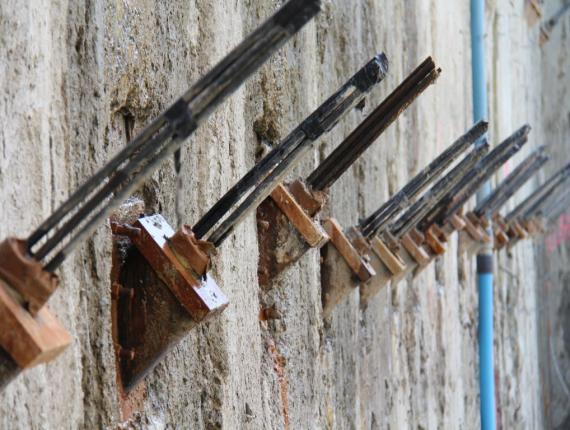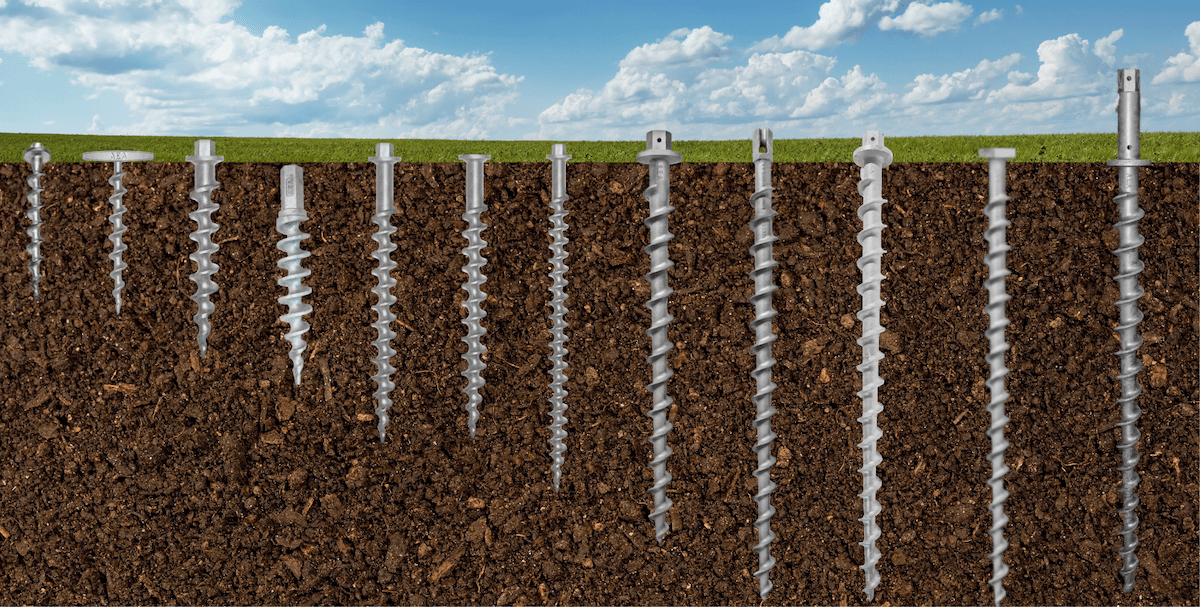How Sturdy Earth Anchors Work: A Comprehensive Overview to Soil Anchoring Solutions
Heavy-duty Earth supports play an important duty in supplying security and assistance in various building and construction applications. By embedding deeply right into the ground, they resist side and upright forces successfully. Various kinds of anchors satisfy various dirt conditions, making them functional. Recognizing their mechanics and setup methods is necessary for optimizing performance. What aspects influence their performance, and exactly how do they compare to typical methods? The answers may amaze you.
Recognizing Durable Earth Anchors
Sturdy Earth anchors function as vital elements in different building and landscape design tasks, supplying stability and assistance in challenging soil problems. These anchors function by being embedded into the ground, where they withstand lateral and vertical pressures. Their layout enables safe accessory to frameworks, ensuring they stay secured against soil motion or exterior loads.The effectiveness of durable Earth anchors mainly depends upon the sort of soil and the anchor's setup depth. Appropriate setup strategies are essential, as they establish the anchor's holding ability. Ecological elements, such as dampness and freeze-thaw cycles, can also affect performance.These anchors are frequently used in applications ranging from safeguarding fencings and keeping wall surfaces to stabilizing short-term frameworks throughout unfavorable weather conditions. Understanding the concepts behind durable Earth supports is vital for specialists seeking to improve the resilience and safety and security of their projects.
Types of Heavy-Duty Earth Anchors
Different types of sturdy Earth anchors are created to fulfill details demands based upon dirt conditions and task requirements. Helical supports, featuring screw-like blades, are efficient in softer dirts, offering high tons abilities and very easy installation. Driven anchors, which are hammered right into the ground, are suitable for rough surfaces and provide prompt lots assistance. Tie-back anchors are typically utilized in preserving wall applications, enabling side assistance by securing right into the ground at an angle. One more type is the cast-in-place support, suitable for concrete applications, as they are incorporated into foundations for enhanced stability. Lastly, dirt screw anchors are functional choices that can be utilized in numerous soil types, offering trusted stress and compression abilities. Each type serves distinctive applications, making sure security and safety and security in building and landscape design projects. Understanding these choices permits for educated choices in choosing the proper Earth anchoring remedy.
The Mechanics of Soil Anchoring

Understanding the technicians of soil anchoring requires an exam of different types of Earth supports and their setup strategies. Each anchor kind provides special features that affect its performance in various dirt conditions. Proper installment approaches are necessary for making best use of the anchoring system's security and performance.
Kinds of Earth Anchors
Earth supports, essential elements in dirt anchoring systems, can be found in a number of kinds, each created for particular applications and soil problems. The most common types include screw anchors, which are twisted right into the ground, providing strong side resistance. Helical supports include blades that allow for efficient installation in different dirt kinds, making them suitable for both short-term and irreversible applications. Driven anchors, commonly made from steel, are hammered right into the soil and work in rocky or dense settings. Auger anchors utilize a helical layout to promote setup in softer dirts. Finally, plate anchors contain a flat plate buried horizontally, dispersing lots over a bigger area, perfect for applications needing high load abilities in cohesive dirts.
Setup Strategies Explained
Proper installation techniques are vital for the efficiency of soil anchoring systems. The process typically starts with website analysis, confirming the selected area can sustain the anchor's load. After identifying the appropriate anchor type, correct hole depth and angle have to be developed. The installment entails driving the support into the ground making use of specific tools, such as hands-on or hydraulic drivers, to achieve ideal embedment. Post-installation, tensioning the support is critical to assure security; this is frequently confirmed with load testing. Furthermore, bordering soil conditions ought to be kept an eye on to avoid displacement. Complying with these techniques not just boosts the support's efficiency but additionally prolongs its life-span, supplying reliable assistance for numerous applications.
Applications of Heavy-Duty Earth Anchors
While sturdy Earth supports are typically connected with construction and landscape design, their convenience reaches a range of applications across various industries. In civil engineering, they supply More Help necessary assistance for maintaining wall surfaces, making sure stability in areas vulnerable to dirt erosion. The aquatic industry uses these anchors for safeguarding docks and marinas, preventing motion triggered by tides and currents. Furthermore, in the telecommunications sector, heavy-duty Earth anchors are significant for supporting cell towers and various other tall frameworks against wind pressures. Agricultural applications also profit, as these supports can safeguard frameworks like greenhouses and animals secure fencing, guaranteeing they hold up against severe climate condition. In addition, in renewable resource projects, such as wind farms, Earth supports play an essential duty in protecting turbine structures, improving overall safety and security and efficiency. This broad variety of applications highlights the flexibility and integrity of durable Earth anchors across various fields.
Advantages Over Typical Anchoring Approaches
Traditional anchoring methods have long been depended upon for stability, heavy-duty Earth anchors provide substantial benefits that improve performance and efficiency. One significant advantage is their premium load-bearing ability, which allows them to endure better forces without failing. This toughness makes them suitable for requiring applications, such as in building and construction and utility installations.Additionally, durable Earth anchors are made for deeper setup, giving greater stability in different dirt problems, including loose or sandy dirts. Their resistance to rust and environmental elements assures a much longer life-span and reduced upkeep costs contrasted to standard methods.Moreover, these supports can be mounted with marginal disruption to the surrounding area, protecting the stability of the landscape. In general, durable Earth supports offer a dependable and effective solution for securing demands, going beyond the limitations frequently connected with conventional anchoring strategies.
Installation Process and Finest Practices
The setup process for dirt anchoring remedies begins with complete prep work and site evaluation to guarantee peak performance. Following this, a step-by-step installation overview provides clear instructions for efficient application (construction site anchors). Sticking to these best practices is essential for attaining lasting and dependable anchoring results
Preparation and Website Evaluation
Effective prep work and extensive site assessment are vital steps in the setup of dirt anchoring remedies. Prior to installation, the soil kind should be evaluated to determine its bearing capacity and viability for securing. Performing a geotechnical survey can offer crucial info concerning soil structure, moisture degrees, and possible ground movement. In addition, recognizing existing frameworks, check here greenery, and utilities is crucial to prevent disturbance during setup. The location should be cleared of particles and barriers to guarantee risk-free access for equipment. Climate condition need to likewise be kept track of, as negative conditions can impact both security and installment effectiveness. By meticulously preparing the website and assessing all appropriate factors, the possibility of effective anchor performance is significantly raised.
Step-by-Step Installation Overview
A complete setup procedure is vital for achieving suitable efficiency of soil anchoring remedies. The installation begins with selecting the proper anchor kind and ensuring the website is clear of debris. Next off, proper opening positioning is identified based upon load demands. Once the location is developed, openings are pierced to the defined deepness and size using the proper tools. The anchor is then placed into the hole, making certain it is aligned properly. After securing the support, soil is backfilled and compressed to enhance stability. It is necessary to comply with maker standards throughout the procedure. A post-installation assessment confirms that the supports are adequately located and working as meant, offering trusted support for the designated application.

Maintenance and Evaluation of Earth Anchors
Regular upkeep and assessment of Earth anchors are important for ensuring long-lasting efficiency and stability. Periodic checks enable the very early detection of concerns such as corrosion, loosening, or dirt movement. Examiners need to seek indications of rust or degradation on the support parts, especially at the link points. In addition, the bordering dirt needs to be evaluated for erosion or adjustments in wetness content, which can impact support effectiveness.It is recommended to establish a routine assessment schedule, preferably at the very least when a year, depending on environmental problems. During inspections, all visible elements must be cleaned up to eliminate dust or debris that could conceal potential problems. Any kind of indications of distress, such as turning structures or uncommon settling, must trigger instant examination. Appropriate paperwork of assessments can help in monitoring support efficiency in time and facilitate timely upkeep activities, making sure the supports stay trusted and functional.
Regularly Asked Inquiries
What Materials Are Heavy-Duty Earth Anchors Typically Made From?
Durable Earth supports are normally built from long lasting products such as galvanized steel or stainless-steel, making sure strength click here to read and resistance to corrosion. These products offer durable assistance and stability in various dirt conditions and applications.
How Do Dirt Problems Affect Support Performance?
Soil conditions significantly affect anchor performance. Variables such as soil kind, wetness material, and compaction affect the support's hold and stability, with natural dirts typically giving much better resistance than sandy or loose soils, affecting overall efficiency.
Can Heavy-Duty Earth Anchors Be Reused After Elimination?
Heavy-duty Earth supports can be recycled after elimination, offered they are evaluated for damage and wear. Appropriate cleaning and upkeep improve their durability, making sure reliable performance in subsequent installments when conditions enable for secure reinstallation.
What Are the Ecological Influences of Utilizing Earth Anchors?
The environmental impacts of making use of Earth anchors include potential soil disturbance, interruption of regional communities, and feasible contamination of groundwater. If utilized sensibly, their advantages frequently exceed these problems, promoting security in numerous applications.
Exactly how Do I Pick the Right Anchor for My Project?

Comments on “Essential Knowledge for Using soil anchoring solutions That Work in Harsh Environments”